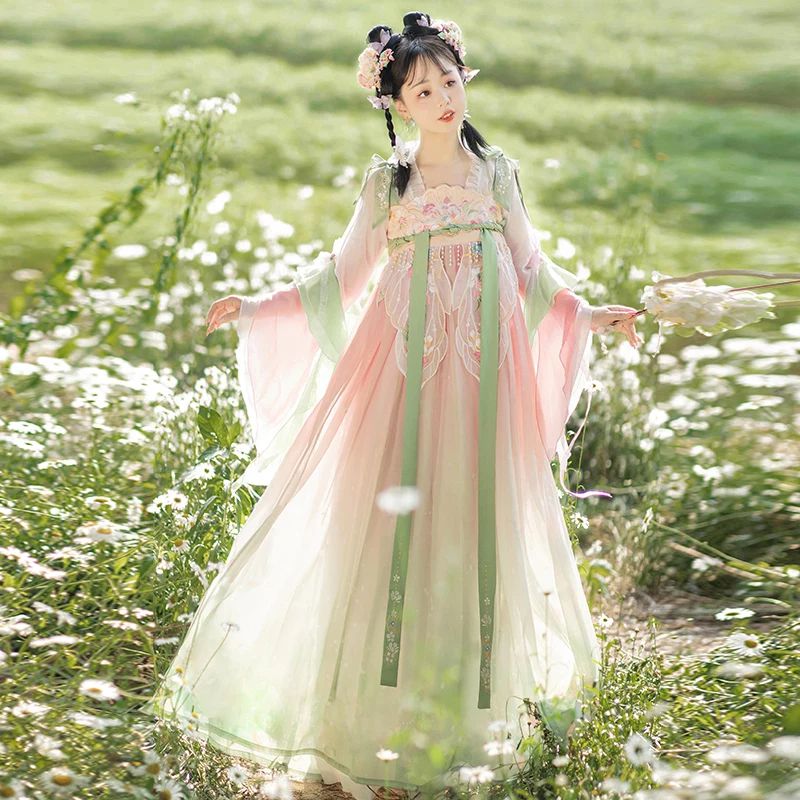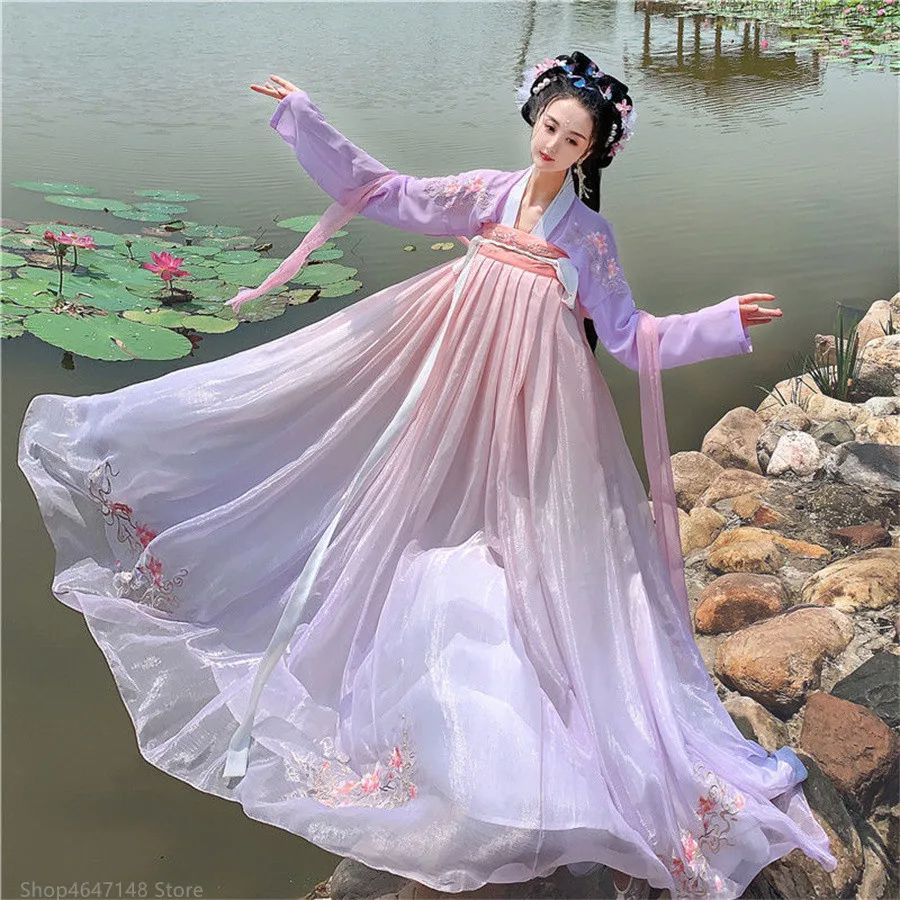The Revival of Hanfu: Exploring the Cultural Significance of the Tang Dynasty Renaissance
Cultural Heritage in Fabric
The Tang Dynasty (618-907 CE) witnessed a golden age of Chinese civilization, leaving an enduring legacy in various aspects of culture, including fashion. The hanfu, the traditional Chinese clothing system, experienced a remarkable renaissance during this period, becoming a symbol of cultural identity and national pride.

Characteristics of Tang Dynasty Hanfu
The Tang Dynasty hanfu was characterized by its flowing lines, vibrant colors, and intricate embroidery. It reflected the cosmopolitan nature of the Tang era, incorporating influences from Central Asia, Persia, and other regions. The clothing system consisted of a long robe (yi) worn over a skirt (qun) or trousers (ku), with a sash (dai) to secure the ensemble.
Modern Revival
The revival of hanfu in the 21st century is a testament to the enduring power of Chinese cultural heritage. This renaissance has been driven by a growing interest in traditional culture, a desire to reconnect with Chinese roots, and a recognition of the aesthetic beauty of hanfu.
Impact on Society
The Tang Dynasty hanfu renaissance has profoundly impacted Chinese society, fostering a sense of cultural pride and identity, particularly among young people. The revival has also stimulated interest in traditional Chinese crafts, such as silk weaving and embroidery.
A Platform for Cultural Exchange
Moreover, the hanfu movement has become a platform for cultural exchange and dialogue. Hanfu enthusiasts from around the world gather at events and online forums to share their knowledge and appreciation of Chinese culture. This has helped promote cross-cultural understanding and foster a global community of hanfu enthusiasts.
A Cultural Phenomenon
The Tang Dynasty hanfu renaissance is not merely a fashion trend but a cultural phenomenon that reflects a deep-seated desire to preserve and celebrate Chinese heritage. It is a testament to the enduring power of tradition and the ability of cultural symbols to inspire and unite people across generations.
Future Prospects
As the hanfu movement continues to grow, it is likely to have a lasting impact on Chinese culture and society. It has the potential to further strengthen cultural identity, promote traditional crafts, and foster cross-cultural dialogue. The Tang Dynasty hanfu renaissance is a vibrant and dynamic movement shaping the future of Chinese culture.
Fabric as a Canvas: Unveiling the Artistic Heritage of Hanfu
Cultural Heritage Through Fabric
In the realm of cultural heritage, fabric serves as a vibrant canvas upon which the threads of history are woven. The Tang Dynasty hanfu renaissance, a contemporary revival of traditional Chinese attire, offers a captivating glimpse into the intricate artistry and cultural significance of hanfu.

Historical Roots
Hanfu, the ancestral clothing of the Han Chinese, embodies centuries of cultural evolution. Its origins can be traced back to the Shang Dynasty (1600-1046 BCE), where it served as a symbol of social status and cultural identity. During the Tang Dynasty, hanfu reached its zenith, becoming an elaborate and highly ornamented garment that reflected the dynasty’s prosperity and cosmopolitanism.
Contemporary Revival
The Tang Dynasty hanfu renaissance, which emerged in the late 20th century, is a testament to the enduring legacy of this ancient attire. Driven by a desire to reconnect with cultural roots, contemporary Chinese designers and enthusiasts have revived the art of hanfu making, meticulously recreating the intricate designs and fabrics of the Tang era.
Diverse Fabrics and Colors
The fabrics used in hanfu are as diverse as the garments themselves. Silk, a luxurious and versatile material, is a staple of Tang Dynasty hanfu. Its shimmering surface and drape create an ethereal elegance befitting the era’s refined aesthetic. Other fabrics, such as cotton, linen, and wool, each possess unique properties and textures.
Symbolism in Color
The colors of hanfu are equally vibrant and symbolic. Red, representing good fortune and prosperity, is a popular choice for festive occasions. Green symbolizes nature and harmony, while yellow is associated with the imperial court. The use of contrasting colors and intricate patterns creates a visually stunning effect that reflects the Tang Dynasty’s love of beauty and ornamentation.
Cultural Significance
Beyond its aesthetic appeal, hanfu holds deep cultural significance. It serves as a tangible link to the past, connecting contemporary Chinese with their ancestors. By wearing hanfu, individuals express cultural pride and contribute to the preservation and transmission of this ancient tradition.
A Cultural Phenomenon
The Tang Dynasty hanfu renaissance is not merely a fashion trend but a cultural phenomenon that celebrates the rich heritage of Chinese textiles and the enduring power of tradition. Through the revival of hanfu, contemporary Chinese are rediscovering their cultural roots and creating a vibrant expression of their national identity.
Threads of Tradition: The Role of Hanfu in Preserving Cultural Identity
A Golden Age of Cultural Brilliance
In the tapestry of Chinese history, the Tang Dynasty stands out as a golden age of cultural brilliance. Among its many legacies, the hanfu, the traditional clothing of the Tang era, has experienced a remarkable renaissance in recent years. This revival is not merely a fashion trend but a profound movement that seeks to preserve and celebrate China’s rich cultural heritage.

Elegance and Sophistication
The hanfu, with its flowing robes, intricate embroidery, and vibrant colors, embodies the elegance and sophistication of the Tang Dynasty. It is a testament to the artistry and craftsmanship of the era. However, during the Qing Dynasty, hanfu was replaced by Manchu-style clothing, leading to a decline in its popularity.
Reviving Interest
In the late 20th century, a growing interest in Chinese history and culture sparked a revival of hanfu. Enthusiasts began to research and recreate traditional garments, using historical texts and archaeological findings as their guide. The movement gained momentum through online forums and social media, where individuals shared their knowledge and passion for hanfu.
Impact on Cultural Identity
The hanfu renaissance has had a profound impact on Chinese society, fostering a sense of national pride and cultural identity among young people. By wearing hanfu, they feel a connection to their ancestors and a deeper appreciation for their heritage. Moreover, the movement has stimulated interest in traditional Chinese arts and crafts, such as embroidery, weaving, and dyeing.
Tourism and Cultural Events
The revival of hanfu has positively impacted the tourism industry. Visitors to China are increasingly drawn to historical sites and cultural events where they can witness the beauty and elegance of hanfu firsthand. This has led to a growing demand for hanfu-related products and services, such as custom-made garments, workshops, and cultural performances.
Challenges and Criticism
However, the hanfu renaissance is not without its challenges. Some critics argue that it is a form of cultural appropriation, as hanfu was originally worn by the Han Chinese ethnic group. Others express concerns about the commercialization of the movement, which could lead to the dilution of its cultural significance.
Enduring Legacy
Despite these challenges, the hanfu renaissance continues to thrive. It is a testament to the enduring power of cultural heritage and the desire of people to connect with their past. As the movement grows, it is likely to have a lasting impact on Chinese society, fostering a deeper understanding of the country’s rich history and traditions.
